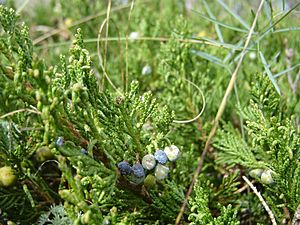Creeping juniper facts for kids
Quick facts for kids Creeping juniper |
|
|---|---|
 |
|
| Foliage and cones | |
| Conservation status | |
| Scientific classification | |
| Genus: |
Juniperus
|
| Species: |
horizontalis
|
 |
|
| Natural range of Juniperus horizontalis | |
| Synonyms | |
|
|
Juniperus horizontalis, often called the creeping juniper or creeping cedar, is a special type of low-growing shrub. It's a kind of juniper that spreads out wide instead of growing tall. You can find it naturally across northern North America. It grows in most parts of Canada, from Yukon all the way to Newfoundland. In the United States, it's found in Alaska and in some areas from Montana to Maine. It even reaches as far south as Wyoming and northern Illinois.
Contents
What is Creeping Juniper?
The name "creeping juniper" really fits this plant! It usually grows only about 10 to 30 centimeters (4 to 12 inches) tall. But it can spread out several meters (many feet) wide. Its branches are quite thin, about 0.7 to 1.2 millimeters across.
What Does It Look Like?
The leaves of the creeping juniper are small and scale-like. They are about 1 to 2 millimeters long. On younger plants, the leaves can be longer, up to 8 millimeters. Young seedlings have needle-like leaves that are 5 to 10 millimeters long.
The plant produces small, berry-like cones. These cones are round and about 5 to 7 millimeters wide. They are dark blue with a pale blue-white waxy coating. Each cone usually holds two seeds, but sometimes one or three. These cones take about 18 months to fully grow.
Creeping junipers have separate male and female plants. This means one plant will only produce male cones, and another plant will only produce female cones. The male cones are small, about 2 to 4 millimeters long. They release their pollen in early spring.
How is it Related to Other Junipers?
The creeping juniper is very similar to Juniperus virginiana, also known as the Eastern Redcedar. They often hybridize (mix their genes) where their natural areas meet in southern Canada. It can also hybridize with Juniperus scopulorum.
Growing Creeping Juniper
Creeping juniper is a very popular plant for gardens. People like to use it as an ornamental plant because it grows low and spreads out. This makes it great for covering the ground. There are over 100 different types, called cultivars, that have been chosen for gardens.
Popular Types of Creeping Juniper
Some well-known types include 'Bar Harbor', 'Blue Acres', 'Emerald Spreader', 'Green Acres', and 'Wiltonii' (also known as "Blue Rug Juniper"). Many of the most popular types have a striking blue-green color. Others can be bright green, yellowish, or even have mixed colors.
Gallery
-
A creeping juniper plant growing in the sand dunes at Pancake Bay Provincial Park in Ontario, Canada.




